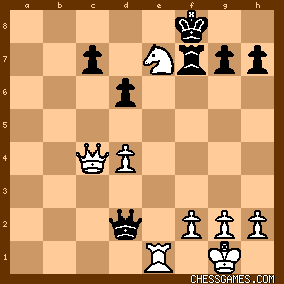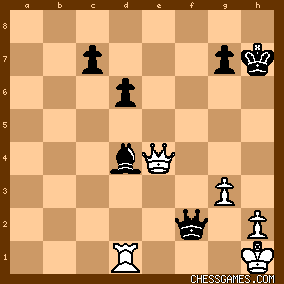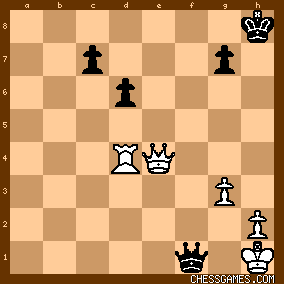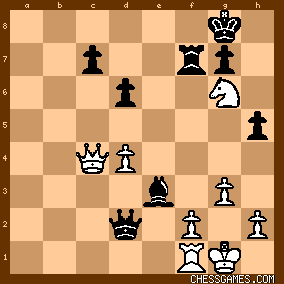|
< Earlier Kibitzing · PAGE 2 OF 2 ·
Later Kibitzing> |
Jul-27-12
 | | FSR: That's it - 33.Nh8 winning the exchange? Too obvious - I figured I must be missing something deep. |
|
| Jul-27-12 | | gofer: I can answer my own question! Pity!
http://www.chessvideos.tv/endgame-t... |
|
| Jul-27-12 | | morfishine: <33.Nh8> |
|
| Jul-27-12 | | Deji: What the...!? |
|
| Jul-27-12 | | Abdel Irada: <Eking out a win>
For a moment, I thought I was participating in a demonstration of the futilitarian principle: The key move, 33. ♘h8, is not hard to see, since it wins an exchange in short order. What is not so easy to see is the way to put Black away, since the exchange is not necessarily sufficient to win. (1) After 33. ♘h8!, ♗xf2†; 34. ♔h1, ♔xh8; 35. ♕xf7, White has the advantage, but not a very satisfying one. I therefore examined other ideas until I'd ruled them out. (2) The most obvious move, of course, is 33. fxe3?, taking a bishop and bringing the open f-file to bear against Black's pinned rook. Unfortunately, this fails prosaically, thanks to the loose knight on g6: 33. ...♕xe3†; 34. ♔h1/♔g2, ♕e4†  , when Black finishes a pawn ahead and with all pieces defended. , when Black finishes a pawn ahead and with all pieces defended. (3) Tempting but pointless is the attempt to transfer the knight to a better square with 33. ♘e7†?!, which after the forced 33. ...♔f8 only improves Black's position by relieving the pin on his rook. Since there is no effective follow-up, this was quickly set aside. (4) No analysis would be complete without a look at the queen sac 33. ♕xf7†?, with the thought of capturing the bishop on e3 with discovered check. But this loses miserably, since Black gets out of check by taking the knight, leaving White with rook against queen. [Continued on next post] |
|
| Jul-27-12 | | Abdel Irada: [Continued from last post]
(5) More intriguing was the try 33. ♕e6?. This looks strong, since it threatens to win the pinned rook with ♕e8† — and in fact does. However, the move also loses, spectacularly so in one variation: After 33. ...♗xf2†, White must move the king to either of two squares. (5.1) 34. ♔g2, ♗xg3†!; 35. ♔xg3 (<declining the bishop with ♔h3/♔h1/♔g1 leads to mate in one; declining with ♖f2 leads to mate in two>), ♕d3†; 36. ♔h4/♔g2, ♕xf1/♕xf1†  . Black is the exchange ahead and has an unstoppable attack. . Black is the exchange ahead and has an unstoppable attack. (5.2) 34. ♔h1, ♕xd4!; 35. ♕e8†, ♔h7; 36. ♕xf7??, ♕e4†; 37. ♕f3 ▢, ♕xf3#. There being no other apparently relevant lines, this brings us back full circle to line (1), and demands that we find a way to win with it. Continuing from above, we find that Black must save his twice-menaced bishop on f2. What I failed to see on the first examination was that 35. ...♗xd4? lost a piece after 36. ♕xh5†, ♔g8; 37. ♖d1!, ♕ moves; 38. ♕d5† with a double attack. Black must therefore consider 35. ...♗e3. For some time, I studied this position, seeking a way to bring in the rook (say via a1 or b1) and forcing mate. Unfortunately, Black meets this with ...♔f8 and appears to escape. Finally, I concluded that the most reliable way to bring home the point might be the quiet 36. d5, when White wins slowly, safely and prosaically. However, something tells me Geller found a faster way to win. :-S |
|
| Jul-27-12 | | bala2603: Aha. Seems Kasparov has taken a cue from this knight move and played against Piget later on . |
|
| Jul-27-12 | | Abdel Irada: Boo! Dorfman played 37. ...♗xd4?, short-circuiting the entire variation. Now we'll never get to see how Geller would have continued against correct defense. |
|
Jul-27-12
 | | perfidious: <Abdel Irada> A top player of long ago (possibly Alekhine?) had something on those lines to say about an opponent who played a move which lost relatively quickly, thereby denying the victor the opportunity to demonstrate the full splendour of his conception. |
|
| Jul-27-12 | | Zatrikion: White cannot take the Bishop since Black Q can take the N after two perpetual checks. All I can see for white is to take the exchange. A possible scenario is: 33.Nh8 Bxf2+
34.Kh1 Kxh8
35.Qxf7 Bxd4
36.Qxh5+ Kg8
37.Qf7+ Kh8
38.Qxc7 (taking back the lost pawns and having the exchange for the ending game) Time to check |
|
| Jul-27-12 | | Marmot PFL: 33 Nh8 is not only playable, but seems the only try for advantage. after 33...Bxf2+ 34 Kh1 there are no more checks and after 34...Kxh8 35 Qxf7 Bxd4 36 Qxh5+ white is better |
|
| Jul-27-12 | | James D Flynn: Candidates fxe3,Nh8,Qe6.
33.fxe3 Qxe3+ 34.Kg2 Qe4+ 35.Qxg6(35.Qg4+Kg2 36.Qe5+ draws by repetition) now if White exchanges pieces on f7 the Black c pawn will win the endgame., if he doesn’t exchange Black will play Kf8 forcing the exchange of Rs with better chances in the endgame.
33.Nh8 Bxf2+ 34.Kh1 Kxh8 35.Qxf7 Bxd4 36.Qxc7 Be5 37.Rf8+ Kh7 and White has run out of useful checks while Black threatens Qe1+ followed by Qe3+ or Qe4+ with a perpetual.
33.Qe6 Bxf2+ 34.Kh1 Qe3 (else White plays Qe8+ and Qxf7) and the threat of Qe4# forces the exchange of Qs and Black will win the endgame. |
|
| Jul-27-12 | | UrVileWedge: Can someone explain to me why Geller didn't play 29 Nxe7+ ? After Kf8 or Kh8, Qe2 seems to hold rather simply. |
|
Jul-27-12
 | | Phony Benoni: <UrVileWedge> After <29.Nxe7+ Kf8>
click for larger view30.Qxe2 is answered by 30...Qxe2 31.Rxe2 Rxe7 regaining the piece. Geller was evidently trying to get more out of the position. White can't hold the extra piece with other moves either, due to the threats to his rook and the f2-square. These probably explain why Geller covered up with 29.Rf1. |
|
| Jul-27-12 | | sevenseaman: <UrVileWedge: Can someone explain to me why Geller didn't play 29 Nxe7+ ? After Kf8 or Kh8, Qe2 seems to hold rather simply.> 29. Nxe7+ Kf8 30. Qe2 Qxe2 31. Rxe2 Rxe7 =. |
|
| Jul-27-12 | | Castleinthesky: Woo Hoo! Nh8-It took a few minutes of pondering and burnt rubber, but it soon became as clear as Los Angeles on a hot muggy day. |
|
Jul-27-12
 | | Jimfromprovidence: There are so many choices here that I managed to hit three drawing moves; I went through 33 Qe6, 33 fxe3 and 33 Ne7+ before I finally found the correct path. |
|
| Jul-27-12 | | kevin86: Brilliant! White "hides" his horse in the corner and wins! |
|
| Jul-27-12 | | Once: In the final position ...

click for larger view... wouldn't you be tempted to play just one more move? Say 39...Kh8 ... and hope and pray that white snaffles your bishop with 40. Rxd4? ... whereupon you slowly reach over the board and nudge your queen forwards one square .... 
click for larger viewI think you'll find that's mate. Very sorry.
I know, I know, a player of Geller's strength should never allow a mate in 1. But you never know ... |
|
| Jul-27-12 | | dragon player: A strange puzzle today. Black's bisshop is hanging, but taking it doesn't
work.
I've looked at it for a while now, and I don't see anything else than this:33.Nh8 Bxf2+
34.Kh1!
Now black has trouble defending the rook, his queen can't do this. 34...Kxh8
35.Qxf7
and white has won the exchange.
Time to check.
----------
Yes, I was right.
5/5 |
|
| Jul-27-12 | | Crispy Seagull: I did spot the fairly obvious Nh8 to win the exchange, but never followed it all the way through to winning the bishop. Nice tactic. |
|
Jul-27-12
 | | LoveThatJoker: Tremendous! A GM Geller puzzle!
<33. Nh8! Kxh8>
[33...Bxf2+ 34. Kh1 Kxh8 35. Qxf7 Bxd4 36. Qxh5+ Qh6 (36...Kg8 37. Rd1! and depending on what Black plays, White wins the B via 38. Qd5+ or 38. Qe8+ Kh7 39. Qe4+) 37. Qe8+ Kh7 38. Qe4+ and 39. Qxd4  ; 33...Qxd4? 34. Qxf7+ and 35. fxe3 ; 33...Qxd4? 34. Qxf7+ and 35. fxe3  ] ] <34. Qxf7 Bxd4 35. Qxc7> White has the more advantageous endgame as he is up the exchange. [35. Qxh5+?! Kg8 (35…Qh6?? 36. Qe8+ Kh7 37. Qe4+ and 38. Qxd4  ) and here Black has survival chances due to his connected passed pawns] ) and here Black has survival chances due to his connected passed pawns] LTJ |
|
| Jul-27-12 | | TheBish: Geller vs Dorfman, 1976 White to play (33.?) "Difficult", even material.
Losing a pawn is 33. fxe3? Qxe3+ 34. Kg2 Qe4+ 35. Kg1 Qxg6. The right way is 33. Nh8!, winning an Exchange. Black can try 33...Bxf2+ 34. Kh1 Qxd4 but 35. Qxf7+ Kxh8 36. Qxf2 is an easy win. Best for Black is probably 33...Kxh8 34. Qxf7 Bxd4 35. Qxh5+, when White is up a full Exchange. |
|
Jul-28-12
 | | FSR: <Once> I had the same thought. Of course, the odds of Geller playing 40.Rxd4 are essentially nil. But then again, I would have said the same thing about Kramnik playing 34...Qe3 in Deep Fritz vs Kramnik, 2006. Might as well play on one more move and hope for the one in 1,000 chance that he has a massive brain fart. That reminds me of a game I played about 30 years ago against a older guy (probably not too much older than I am now, gulp) named Ben Greenstein, who was rated far below me. I think I was 2000-something and he was a 1600. A fish. Easy pickings. He had played the Stonewall Attack. I was unimpressed and castled prematurely, whereupon he launched a pawn storm and got a big attack. I spent a lot of time figuring out how to defend, but then he castled queenside and suddenly <I> got a raging attack. Alas, in time pressure I misplayed what should have been a winning attack, playing three consecutive weak moves and allowing him to relaunch his attack. After we reached the time control, I disgustedly viewed the wreckage of my position. I was three pawns down and completely crushed. I reached across the table intending to shake his hand to resign. I felt sick. How could I blow such a position? And a win would probably have given me the club championship, which I could now forget about. But instead of reaching his hand, my hand, almost as if it had a mind of his own, grabbed my c-pawn and played ...c3 attacking his queen on d2 and the pawn on b2 in front of his king. It was a vain attacking gesture, which he could easily have rebuffed. But he played an inferior response, after which I felt a glimmer of hope. I played another attacking move, and he again responded with an inferior move. He wasn't taking my counterattack seriously, and indeed it wouldn't have been serious if he had taken a few minutes to analyze it and play the best moves. I played a third attacking move, he yet again responded weakly, and suddenly I had a winning attack again! The game was adjourned (they had adjournments back in those days) in a position that was now - once again - easily winning for me. I won the game and the club championship with 6.5-2.5, beating out Tony Sillars by half a point. Incredible. Although unfortunately I don't have the scoresheet anymore, it's probably one of the two greatest swindles of my life, the other being F Rhine vs S Nagle, 1997. (Take a look at the position after White's 27th move in that game, and try to imagine how Black - then a rising young expert and now a FIDE Master - could possibly <lose> such a position.) |
|
| Jul-28-12 | | David2009: I came to this puzzle too late yesterday to comment usefully. Here's the puzzle position

click for larger view
with a link to Crafty End Game Trainer:
http://www.chessvideos.tv/endgame-t...
The robot duly finds the best defence (33.Nh8 Kxh8! 34.Qxf7 Bxd4 35.Qxh5+ Kg8) which I could not crack last night. Coming to it today with a fresh mind, I found that the win starting 36.h4 intending Qg5 etc was reasonably plain sailing. After Queens are exchanged the exchange advantage is too powerful. Enjoy exploring the variations from the White side! |
|
 |
|
< Earlier Kibitzing · PAGE 2 OF 2 ·
Later Kibitzing> |
|
|
|





